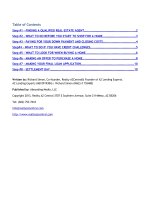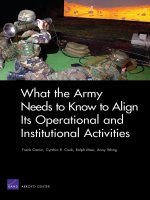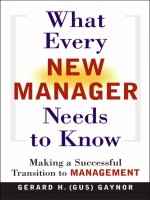Marine pollution what everyone needs to know®
Bạn đang xem bản rút gọn của tài liệu. Xem và tải ngay bản đầy đủ của tài liệu tại đây (3.05 MB, 296 trang )
Tai Lieu Chat Luong
MARINE POLLUTION
WHAT EVERYONE NEEDS TO KNOW®
MARINE POLLUTION
WHAT EVERYONE NEEDS TO KNOW®
JUDITH S. WEIS
1
3
Oxford University Press is a department of the University of Oxford.
It furthers the University’s objective of excellence in research, scholarship,
and education by publishing worldwide.
Oxford New York
Auckland Cape Town Dar es Salaam Hong Kong Karachi
Kuala Lumpur Madrid Melbourne Mexico City Nairobi
New Delhi Shanghai Taipei Toronto
With offices in
Argentina Austria Brazil Chile Czech Republic France Greece
Guatemala Hungary Italy Japan Poland Portugal Singapore
South Korea Switzerland Thailand Turkey Ukraine Vietnam
Oxford is a registered trademark of Oxford University Press
in the UK and certain other countries.
“What Everyone Needs to Know” is a registered trademark of
Oxford University Press.
Published in the United States of America by
Oxford University Press
198 Madison Avenue, New York, NY 10016
© Oxford University Press 2015
All rights reserved. No part of this publication may be reproduced,
stored in a retrieval system, or transmitted, in any form or by any means,
without the prior permission in writing of Oxford University Press,
or as expressly permitted by law, by license, or under terms agreed
with the appropriate reproduction rights organization.
Inquiries concerning reproduction outside the scope of the
above should be sent to the Rights Department,
Oxford University Press, at the address above.
You must not circulate this work in any other form
and you must impose this same condition on any acquirer.
Library of Congress Cataloging-in-Publication Data
Weis, Judith S., 1941–
Marine pollution : what everyone needs to know / Judith S. Weis.
pages cm.
Includes bibliographical references and index.
ISBN 978–0–19–999668–1 (alk. paper)
1. Marine pollution. 2. Marine ecology. I. Title.
GC1085.W45 2015
577.7'27—dc23
2014009013
1 3 5 7 9 8 6 4 2
Printed in the United States of America
on acid-free paper
CONTENTS
PREFACE
ACKNOWLEDGMENTS
1.Introduction to the Marine Environment
and Pollution
XV
XIX
1
What is the marine environment?
1
What are some basics of marine ecosystems and food webs?
1
Why is there concern about the state of the oceans?
3
What is a contaminant? Is there a difference between a contaminant
and a pollutant?
4
What are the major sources of pollution in the marine environment?
5
What are the major ways that land-based pollutants enter the marine
environment?
6
Which pollutants enter the ocean from the air?
7
Can objects in the water cause pollution?
8
How can aquaculture cause pollution?
8
Once in the water, what happens to the pollutants?
9
How do chemicals get into marine animals?
10
What is toxicity?
11
What effects can pollutants have besides killing living things?
12
vi Contents
How is the degree of toxicity measured?
14
How can field studies be used to understand toxicity?
14
Why are some species more sensitive to pollution than others?
15
What laws regulate marine pollution?
16
Why are some contaminants that have been banned still a problem?
18
How extensive and severe is marine pollution around the world?
18
2.Nutrients
20
Why are nutrients considered pollutants, since they are required
for life?
20
Where do the nutrients come from?
20
How does a sewage treatment plant work?
22
What is Combined Sewer Overflow (CSO)?
24
What are Concentrated Animal Feeding Operations (CAFOs)?
25
What effects do excess nutrients have, or what is eutrophication?
26
What effects are seen in seagrasses?
27
What effects are seen in coral reefs?
28
What is a dead zone?
29
Can excess nutrients damage salt marshes?
30
How widespread is eutrophication?
31
What are Harmful Algal Blooms (HABs)?
32
What are some harmful algal species?
33
How widespread is their occurrence?
35
What can be done to reduce farm runoff?
36
What can be done to reduce runoff from cities and suburbs?
38
What can be done about combined sewer overflow?
39
What techniques in the water can reduce effects of eutrophication?
40
What is the prognosis for eutrophication in the future?
41
Contents vii
3.Marine Debris
42
Why is marine debris so abundant?
42
Where does marine debris come from?
42
What are the major constituents of debris?
43
What happens to the plastic? Does it break down?
44
How is debris in the ocean measured?
45
How much is there?
45
Why does debris accumulate in large patches in the middle of the ocean? 46
Where else does debris accumulate?
47
Granted it is ugly, but can the litter harm marine life?
48
What problems are caused by derelict fishing gear?
53
What are the biggest pieces of marine litter?
55
Can marine debris harm people?
56
What can be done about it? Can cleanups be effective?
56
What about public education?
58
Are there laws to reduce marine litter?
58
Can new technologies reduce the problems of marine debris?
61
4.Oil and Related Chemicals
63
What are the components of oil?
63
What are polycyclic aromatic hydrocarbons (PAHs)?
63
What are the major sources of oil in the ocean?
65
What happens to the oil after it is spilled?
66
What happened with the Exxon Valdez?
66
What were the causes of the accident?
67
What actions were taken after the spill to protect shorelines?
68
How was the spill cleaned up?
68
Have there been some resulting policy changes to prevent future spills?
70
viii Contents
What happened with the well blowout in the Gulf of Mexico?
70
What responses were taken?
70
Why was the use of dispersants so controversial?
71
What happened to the oil and dispersants?
71
What were the overall impacts to the ecology of the Gulf?
73
What happens when oil reaches shorelines?
74
How does oil harm marine birds and mammals?
75
What kinds of toxic effects does oil produce in other marine animals?
75
How long do effects of oil spills last?
78
Can oiled birds and sea otters be rehabilitated?
80
How can oil spills be cleaned up?
80
What are the trends in oil spills over the decades?
81
5.Metals
83
What are the major sources of metal pollutants?
83
What are some highly mercury-contaminated sites?
85
How does the chemical form of the metal affect what it does?
86
Where do metals concentrate in the environment?
88
What are the toxic effects of different metals?
89
What can organisms do to defend themselves against metal toxicity?
94
Can elevated levels of metals in seafood be a risk to humans?
94
What are the trends in metal pollution?
95
What can be done to reduce metal pollution?
95
What is natural attenuation?
96
What is capping?
96
What is Confined Aquatic Disposal (CAD)?
97
What is bioremediation of metals?
97
What is phytoremediation?
98
Contents ix
6.Pesticides and Industrial Organic Chemicals
102
What are the sources of pesticides to the marine environment?
102
What happens to these chemicals after they enter the water?
102
What is the importance of the book Silent Spring?
105
What are some newer types of pesticides?
105
What are “third-generation” pesticides?
107
How are pesticides regulated?
108
What is integrated pest management?
109
What are the effects of pesticides on nontarget organisms?
109
What is endocrine disruption?
110
What are biomarkers?
112
What kinds of population level effects can be produced?
112
What community level effects can be produced?
113
What can marine organisms to do defend themselves against
toxic effects?
113
What are the trends in pesticide contamination?
114
What are polychlorinated biphenyls (PCBs)?
114
How did PCBs get into the marine environment?
115
What are Dioxins?
118
How do they get into the marine environment?
119
What effects do they have?
120
Can PCBs or dioxins be a risk to people who eat seafood?
120
What can be done about organic chemical pollution?
121
7. Emerging Concerns
122
What other types of contaminants are we beginning to learn about?
122
Why are pharmaceuticals and personal care products (PPCPs)
a concern?
122
What can be done about PPCPs?
126
x Contents
What are polybrominated diphenyl ethers (PBDEs) and why are they a
concern in the marine environment?
126
What is the problem with fluorinated compounds?
128
What is the concern about alkylphenols?
129
What are nanoparticles and what is the concern about them?
129
Are existing regulations adequate to protect against harm to marine
life, wildlife, and humans by these new chemicals? Are there any
technological improvements?
132
What is Noise pollution?
132
What types of noise occur in the ocean?
133
What effects are produced by noise pollution?
134
What can be done about noise pollution?
136
Are there concerns about radioactivity in the marine environment?
139
What is light pollution?
140
What can be done about light pollution?
141
8.Bioaccumulation and Biomagnification
143
What is bioaccumulation and what is biomagnification?
143
What happens once a metal is taken up into an organism?
143
Where and how are metals stored in organisms?
144
How are organic contaminants taken up by organisms?
145
How do organisms metabolize organic contaminants?
146
Which marine organisms are good sentinels for bioaccumulation and
biomagnification of chemicals?
147
What are safety issues for humans who consume seafood that may be
contaminated?
148
What is Minamata disease?
149
Are there any concerns about mercury pollution in seafood today?
150
Can metal pollution be found in calcium supplements derived from
oyster shells?
152
What problems can result from eating seafood containing organic
contaminants?
152
Contents xi
Can dioxin contamination be found in seafood?
155
Can contaminants be found in fish oil supplements?
156
How can eating fish or shellfish that have accumulated HAB toxins
cause disease?
157
What is Paralytic shellfish poisoning (PSP)?
157
What is diarrhetic shellfish poisoning (DSP)?
158
What is neurotoxic shellfish poisoning (NSP)?
159
What is amnesic shellfish poisoning (ASP)?
159
What is Ciguatera?
160
How can the incidence of poisoning by marine toxins be reduced?
161
9.Climate Change and Ocean Acidification
163
What causes global warming or climate change?
163
What problems are happening or expected to happen in the marine
environment because of climate change?
163
Why are coral reefs particularly vulnerable?
164
What happens in polar regions?
166
Can climate change affect the distribution of species?
167
Can climate change have effects on aquaculture?
168
Can climate change affect the size of animals?
169
Can climate change affect predator/prey interactions?
169
What effects can happen from sea level rise?
170
Why is sea level rising faster than was predicted?
172
What can be done about sea level rise?
172
What is pH?
173
What is ocean acidification?
173
What effects are produced by ocean acidification?
174
Hasn’t ocean pH changed in the past? Why is this different? Will
marine organisms be able to adapt?
176
Which species are most threatened by ocean acidification?
176
xii Contents
How can organisms protect themselves against effects of
warming and acidification?
180
What economic effects could result from Ocean Acidification?
182
What can we do to mitigate effects of ocean acidification?
182
10. Biological Pollution
186
Where does microbial pollution come from?
186
How is microbial pollution detected?
187
What kind of diseases may result from exposure?
187
How can people know if it is safe to swim at their favorite beach?
188
What are invasive species?
189
How do they get to new locations?
189
What are some invasive marine fishes and what harm do they do?
192
What are some invasive jellies and what harm do they do?
193
What are some invasive crabs and what harm do they do?
195
What are some invasive sedentary attached organisms and what
harm do they do?
198
What are some invasive seaweeds and what harm do they do?
199
What are some invasive marsh plants and what harm do they do?
200
Can an alien species do some good?
201
What can be done to prevent new invasive species from arriving?
202
What can be done after an invasive species has arrived?
204
What can be done after a species has become abundant?
205
Can invasive species be controlled by eating them?
207
11. Regulating and Reducing Pollution
210
What is the Ocean Health Index?
210
What is the Law of the Sea?
212
What is MARPOL?
212
What is the London Convention?
213
Contents xiii
What national laws in the United States promote clean water?
213
What is NOAA’s Role in the United States?
218
How does the European Union regulate marine pollution?
219
What are some success stories?
221
How can we reduce pollution from aquaculture?
223
What is “Green Chemistry?”
224
Since climate change is such a major threat, are there any effective
national and international policies to curb it?
225
What steps can local and state governments take to reduce pollution? 226
What actions can individual citizens take to reduce marine pollution? 230
What are the overall status and trends of marine pollution?
REFERENCES
INDEX
233
237
253
PREFACE
Many people throughout the world were horrified to read daily
reports about the huge volume of oil spewing from the drilling
rig Deepwater Horizon in the Gulf of Mexico for many months
in 2010. People were similarly riveted reading the news and
seeing on TV photos of the oil-covered birds and sea otters
in Prince William Sound, Alaska after the Exxon Valdez spill
in 1989. These spectacular tragic events are fortunately rare.
People may also become aware of marine pollution through
some smaller events such as a fish kill in a local area, excessive
debris or seaweed littering the beach, or discolored water from
an algal bloom. These visible signs of marine pollution are not
all there is. There are many types of pollution that have no
visible signs and are only detected by sophisticated chemical
analysis. In this case, what you don’t know can sometimes hurt
you—and if it doesn’t hurt us, it might hurt marine organisms.
The marine environment is under assault from overfishing,
habitat loss, and pollution. New kinds of pollutants (“contaminants of emerging concern”) include both new pollutants and
old pollutants that no one ever paid attention to before. These
include pharmaceuticals that are designed to have effects on
the body at very low concentrations. The unsightly volumes
of marine debris, mostly plastic, washing up on beaches and
collecting in great garbage patches in the oceans is something
that most people have heard about. Marine debris made the
xvi Preface
headlines in March and April 2014 when the search and rescue teams seeking the missing Malaysia Airlines Flight 370
discovered that the ocean is full of garbage. When ships were
able to retrieve “suspicious” items that planes had spotted, it
turned out not to be debris from the missing plane, but ordinary garbage swirling around in the ocean.
New awareness of the damaging effects of loud noise on
marine animals, especially mammals, is of great concern,
as it may relate to whale beaching incidents. There has been
increasing concern and attention in recent years to the effects
of ocean acidification, caused by increased levels of carbon
dioxide in the atmosphere. While much of the concern and
attention is about impaired shell formation, people are also
discovering effects of ocean acidification on physiology and
behavior as well. Perhaps the most widespread and serious
type of pollution worldwide is eutrophication due to excess
nutrients, which stimulate algal blooms and reduce the level of
oxygen. While eutrophic areas and “dead zones” are increasing around the world, there is also some good news in that
many persistent organic pollutants have been banned and are
no longer manufactured (even though they still remain in sediments and accumulate in marine life). Also, the frequency of
oil spills has gone down in the past few decades. In addition
to this reduction of inputs of some historical pollutants, efforts
have begun to physically remove highly contaminated sediments from some of the estuarine toxic hot-spots in the United
States under the auspices of the Superfund Program.
This book, like others in the What Everyone Needs to Know®
series, is intended for the general public, including policymakers, naturalists, environmentalists, students, and scientists in
other fields. I hope it will provide greater understanding and
stimulate greater interest in the topic, and I hope that a more
educated public will strongly support taking action to reduce
marine pollution. In this book I cover the visible and the invisible types of marine pollution—where it comes from, what
it does, and how we might be able to reduce it. Chapters are
Preface xvii
organized by type of pollution. In addition to the usual types
of pollution, there is a chapter dealing with invasive species,
not always considered a type of pollution, under the category
of biological pollution. I also have a chapter about climate
change—comprising global warming, sea level rise, and ocean
acidification—and effects on marine life. Within each chapter
I include questions that you may have thought about, including potential effects of the pollutants on our own health, and
many questions you may not have wondered about, including
topics such as the fate of chemical pollutants in the marine
environment, what effects pollutants have on marine organisms, and how marine organisms cope with different types of
pollutants. I hope that in both cases you will find the answers
interesting and useful. Perhaps they will stimulate you to
think of additional questions that you would like to know
about. The final chapter covers prospects for the future and
includes sections on international and national laws regulating pollution, how states and municipalities can reduce pollution, and steps that individuals can take to reduce pollution.
A large number of suggestions are provided on how you can
make a difference in reducing marine pollution.
ACKNOWLEDGMENTS
I would like to thank my husband, Dr. Peddrick Weis, for his
valuable suggestions as I was writing this book, his assistance
with the figures, and his role as a frequent research partner
during many years of studying effects of pollution on marine
organisms. I am very grateful to Rachel Carson for her books
about the sea that fostered my interest in marine biology,
and for writing Silent Spring, which stimulated my interest in
pollution. I also thank John and Winona Vernberg, Anthony
Calabrese, and Fred Thurberg, who organized a series of conferences on marine pollution in the 1970s and 1980s that were
instrumental in guiding my early research directions in the
field. The many graduate students and postdocs who worked
in my lab on pollution-related research topics have contributed
a great deal. I thank Jeremy Lewis of Oxford University Press
for his encouragement and sound advice throughout the process of creating this book. I am also grateful to the governmental and nongovernmental environmental organizations that
are working to reduce pollution in the oceans and elsewhere.
MARINE POLLUTION
WHAT EVERYONE NEEDS TO KNOW®
1
INTRODUCTION TO THE
MARINE ENVIRONMENT AND
POLLUTION
What is the marine environment?
As used in this book, the marine environment covers not only
the ocean, but estuaries (e.g., bays), which are coastal areas
where the seawater is diluted with freshwater coming from
rivers and streams, or sometimes groundwater. Much of the
pollution is concentrated in these shallow coastal areas, which
are often next to urban centers and other concentrations of
humans who are responsible for the pollution.
What are some basics of marine ecosystems and food webs?
Marine ecology is a branch of ecology dealing with the interrelations of organisms living in the oceans, shallow coastal
waters, and on the sea shore. Organisms interact through the
roles they play as producers, consumers, and decomposers.
Primary producers are plants that take in inorganic carbon
dioxide and water, and through the process of photosynthesis make organic materials (sugars) using light energy from
the sun. They are the first step of the food web. Primary consumers are herbivorous animals that eat the plants; secondary
consumers are carnivorous animals that eat the herbivores;
2 Marine Pollution
third-level consumers are carnivores that eat other carnivores;
and decomposers are microorganisms (such as bacteria and
fungi) that break down the organic materials from the plants
and animals (excretory products and dead bodies) into inorganic materials, which are eventually reused by producers.
The decomposers are concentrated in the sand or mud on
the bottom, and play an essential role in recycling materials.
There are more producers than consumers, more primary consumers than secondary consumers, and so on up the chain,
because at each step in the food chain a great deal of energy is
lost—it is not efficient. So top carnivores (for example sharks)
are the rarest animals.
The most important primary producers in the ocean are a
diverse group of microscopic floating single-celled photosynthetic organisms called phytoplankton. They are the basis of
the food web that supports the rest of oceanic life. They are
widely distributed in huge numbers, but occur near the surface of the water only down as far as light penetrates, since
light is essential for photosynthesis. Phytoplankton are eaten
by small floating animals called zooplankton. Zooplankton
consist of a wide variety of different types of generally small
animals, some of which spend their whole life as small plankton, while others are larval stages of larger animals such as
clams or crabs that will subsequently go to the bottom to live
as adults. Zooplankton, in turn, are eaten by small fish, which
are eaten by larger fish, which may be eaten by very large fish
(or other large animals such as marine mammals). Animals
that live on the bottom are called benthos; some benthic animals obtain their food by filtering the plankton, while others
consume decaying plant or animal material (called detritus)
that sinks down to the bottom.
In shallow coastal areas or estuaries, additional kinds
of primary producers are found: larger algae (seaweeds) or
rooted plants like seagrasses that live attached on the bottom,
since the light can penetrate through the shallow water. These









